Schneider Shorts 8 September 2023 – a German party has science on its side, a retired fraudster sanctioned by ORI, a journal scrutinised, putin’s daughter publishes in MDPI, with high- and low-profile retractions, an Israeli-super-genius, brain hacks, and finally, why russo-iranian papermillers are false friends.
Table of Discontent
Science Elites
- I totally condemn the war in Ukraine – Kostya Ostrikov and russo-iranian papermillers
- Putin’s daughter in MDPI – sanctions, shmanctions
- Research misconduct by recklessly reporting – ORI sanctions Andrew Dannenberg
- Vote to live forever – A German party promises eternal life with science
Scholarly Publishing
- A report on Toxicology Reports – Sholto David analysed journal for image duplications
Retraction Watchdogging
- Author Elke Stein disagrees – Marc Tessier-Lavigne resigns and retracts 2 Science papers
- Frontiers in Retractions – retractions for Mostafa Jarahian and other papermillers
- High number of concerns – Argentinian researcher María Giselle Peters loses a paper
- Wake up and smell the coffee – PI announces to retract paper by rogue student
Science Breakthrough
- Hasn’t been done before – Jacob Hanna that close to several Nobel Prizes
- Hope to one billion individuals – eat what you want with Korean scientists
- A 226% increase in cognitive capacity – get smart with Procter & Gamble
Science Elites
I totally condemn the war in Ukraine
Maybe you recall Kostya “Ken” Ostrikov, the greatest nanotechnology researcher of all times, youngest professor in Ukraine, presently professor at Queensland University of Technology in Australia. He featured in earlier Friday Shorts, especially here.
Ostrikov went from “THANK YOU!” email to not replying to me at all, because he recently had to correct a papermilled forgery with his Iranian friends.
Back in April 2023, Ostrikov, who collaborates with russian, belorusian and Iranian authors, wrote me this, referring to a close family connection:
“Let me assure you that I totally condemn the war in Ukraine”
Well, now Ostrikov was caught on publishing a massive forgery with some Iranians and two russians: Alexander Mukasyan (presently professor at University of Notre Dame in USA) and the papermiller Dmitry Moskovskikh (professor at National University of Science and Technology (MISIS) in Moscow). The russo-iranian papermilled fabrication was submitted to MDPI in August 2022 and published in OCtober 2022, is this is how Ostrikov tried to console himself over the Iran-assisted russian genocide on his home country?
Mohammad Abedi, Atefeh Asadi , Saeed Sovizi , Dmitry Moskovskikh , Kostya (Ken) Ostrikov , Alexander Mukasyan Electrical and Heat Distributions and Their Influence on the Mass Transfer during the Flash Spark Plasma Sintering of a Cu/Cr Nanocomposite: Experiments and Numerical Simulation Materials (2022) doi: 10.3390/ma15207366





The MISIS-affiliated first author Mohammad Abedi replied with a lengthy word salad on PubPeer, ending with:
“Consequently, at the nanoscale level scrutinized in this study, the manifestation of the atypical microstructure, often described as “similarities,” is entirely anticipated and substantiated as a direct consequence of the potent applied current within the material. Once again, I extend my heartfelt appreciation for your attention to this matter.“
Ostrikov did not reply, also not to my email. Also the ethics department of his university ignores my emails. But then again, in Australia, research fraud is what is expected from a professor.
The above paper is gathering citations, for example from the papermiller Arash Karimipour who apparently bought the manuscript Azodinia et 2023, mass-referencing Abedi and his russian boss Moskovskikh:
“Numerical studies are widely used in research fields [34–36].”
The reference 35 is to Abedi et al 2022. In fact, Abedi, Moskovskikh and Mukasyan seem to regularly buy or extort citations from fellow papermillers, here Dumitru Baleanu (He et al 2023). Some fine russian friends our Ukrainian patriot Ostrikov made.
Russkiy Mir at Elsevier and MDPI
Alexander Magazinov presents you two russian professors whom Elsevier and MDPI consider respectable: a Lt Colonel of putin’s mass-murdering army, and a machine-gun totting rascist. Both buy from papermills.
The Queensland University of Technology research ethics department eventually announced to investigate this case:
“QUT takes these concerns seriously, and we are assessing this matter in accordance with our policy MoPP D/2.7 Managing and investigating potential breaches of the QUT Code for responsible conduct of research. “
Putin’s daughter in MDPI
Russian dissident media “Mozhem obyasnit“ (MO, Можем объяснить, We Can Explain) reports on Telegram (translated):
“Putin’s daughter continued to publish in scientific journals in the United States and Switzerland after the start of the war. Her articles are published despite Western sanctions
The president’s eldest daughter, Maria Vorontsova, a PhD of medical sciences and an endocrinologist by education, continues to publish in Western scientific journals, MO found. Links to her publications are available on the ISTINA website of Moscow University, where scientific texts of all university staff are collected.
She writes articles on endocrinology and medicine for American and Swiss publishers: The Endocrine Society and MDPI Publishing. In 2022 and 2023, four texts by Vorontsova were published […] – three of them after the war and one at the beginning of February 2022. Vorontsova publishes articles not alone, but in co-authorship with colleagues at Moscow State University, including those at the Faculty of Fundamental Medicine, where she occupies the post of deputy dean since 2022.”
Boycott Russian Science (and Everything Else) – Thoughts on War in Ukraine
The state it’s in, we don’t need Russian science anyway.
These are the 4 papers, 3 by the Switzerland-based MDPI and one by US learned society:
- 2023 Makarova Maria, Nemtsova Marina, Danishevich Anastasiia, Chernevskiy Denis, Belenikin Maxim, Krinitsina Anastasiia, Baranova Elena, Sagaydak Olesya, Vorontsova Maria, Khatkov Igor, Zhukova Lyudmila, Bodunova Natalia, Nikolaev Sergey, Byakhova Mariya, Semenova Anna, Galkin Vsevolod, Gadzhieva Saida “The CFTR Gene Germline Heterozygous Pathogenic Variants in Russian Patients with Malignant Neoplasms and Healthy Carriers: 11,800 WGS Results” International Journal of Molecular Sciences, (2023) DOI: 10.3390/ijms24097940
- Lutsenko A., Belaya Z., Nikitin A., Solodovnikov A., Lapshina A., Koshkin P., Vorontsova M., Rozhinskaya L., Melnichenko G., Dedov I. “Circulating Plasma MicroRNA in Patients With Active Acromegaly” Journal of Clinical Endocrinology and Metabolism, (2022) DOI: 10.1210/clinem/dgab695
- Kulebyakin K., Tyurin-Kuzmin P., Sozaeva L., Voloshin N., Nikolaev M., Chechekhin V., Vigovskiy M., Sysoeva V., Korchagina E., Naida D., Vorontsova M. “Dynamic balance between PTH1R-dependent signal cascades determines its pro- or anti-osteogenic effects on MSC” Cells, (2022) DOI: 10.3390/cells11213519
- Kondratyeva S.A., Voronina T.A., Nesmelov A.A., Miyata Y., Tokumoto S., Cornette R., Vorontsova M.V., Kikawada T., Gusev O.A., Shagimardanova E.I. “Intracellular localization and gene expression analysis provides new insights on LEA proteins’ diversity in anhydrobiotic cell line” Biology (2022) DOI: /10.3390/biology11040487
The main point is that Vorontsova has been sanctioned by various countries including where the publishers legally reside: USA and Switzerland. It is a crime to do business with sanctioned entities. But for such a celebrity, the loyal daughter of a mass-murdering fascist, the publishers were eager to make exceptions. By the way, MDPI owner Shu-Kun Lin is a Trump fan and a racist. Guess whose side he is in the Russo-Ukrainian war.
MDPI and racism
In 2019, MDPI published a Special Issue “Beyond Thirty Years of Research on Race Differences in Cognitive Ability”, one year later its owner Shu-Kun Lin expressed admiration for Trump and said “Black Lives Matter. White Lives Matter. All Lives Matter.”
Research misconduct by recklessly reporting
HHS-ORI published its findings of research misconduct against Andrew Dannenberg, who was previously forced to retired by Weill Cornell (read here). And you can read here about Dannenberg’s fake science, many of which have been by now retracted:
The wizard men curing breast cancer
A breast cancer foundation celebrates its research heroes. Read now here about how great US scientists from Harvard, MIT, Weill Cornell and MD Anderson cure cancer.
This is from HHS-ORI case summary:
“Based on the report of an investigation conducted by Weill Cornell Medical College (WCMC) and additional analysis conducted by the Office of Research Integrity (ORI) in its oversight review, ORI found that Andrew Dannenberg, M.D., (Respondent), who was a Professor of Medicine, Department of Medicine, WCMC, engaged in research misconduct in research supported by U.S. Public Health Service (PHS) funds, […] ORI found that Respondent engaged in research misconduct by recklessly reporting falsified and/or fabricated data in the following twelve (12) published papers […]
Respondent recklessly reported falsified and/or fabricated Western blot image data that were reused, with or without manipulation to conceal their similarities, and falsely relabeled as data representing different experiments or proteins in sixty (60) figure panels included in twelve (12) published papers. In the absence of reliable image and numerical data, the figures, statistical analyses, and related text also are false.”
Dannenberg agreed to have his research supervised for 7 years, by a “committee of 2 senior faculty members“. Thing is, the 67-year-old cancer researcher is “retired” and has no lab anymore.
Vote to live forever
Next month, on October 8th, we will have state elections here in Hesse, Germany. Now imagine my face when I saw this Partei für schulmedizinische Verjüngungsforschung (Party for Biomedical Rejuvenation Research) advertising on lampposts. They promise their voters to extend life span to “thousands of years”, asking on the poster: “Where do you want to live in 800 years?”
The party was founded in 2015, used to be called Partei für Gesundheitsforschung (Party for Health Research), it is officially registered and active Germany-wide. It has self-reportedly 321 members (status November 2022), and this is their website: mehr-forschung.de or verjuengungsforschung.de. The founder is someone named Felix Werth from Berlin. His highest academic degree is a BSc in biochemistry (“Grade: 1,7”), so the man knows what he is talking about.
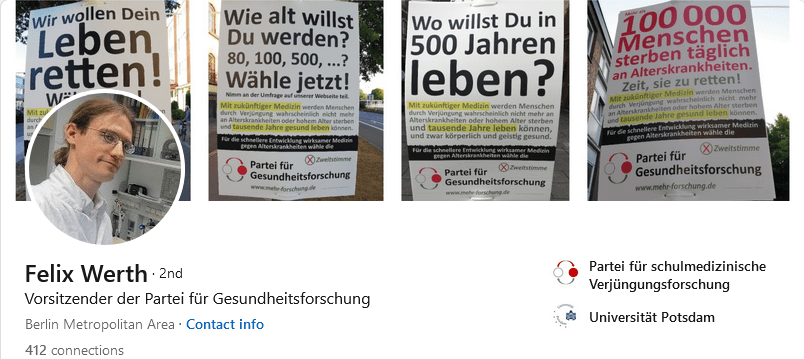
The party promises to end ageing and death already in 10-20 years with enough funding (10% of total state budget, to be precise), and this is the science they plan to implement (translated):
“The scholarly publication The Hallmarks of Aging , which describes the repair approach, is the most cited scholarly publication in the field of aging research in the last decade. Numerous startups, research institutes and university research groups are already working on the implementation of the repair approach, but unfortunately by far not enough.”
Lopez-Otin and Kroemer: birds of a feather flock together
Following my reporting, the cancer researcher Carlos López-Otín abandoned his ERC-funded 36-member-strong “Degradome” lab at the University of Oviedo in Spain and moved in with his collaborator in Paris, France, Guido Kroemer. Yet Lopez-Otin’s data integrity issues seem as poppycock compared to what Kroemer and his life partner Laurence Zitvogel dished out to the scientific…
Yes, this is the bullshit review by Guido Kroemer and Carlos-Lopez-Otin, two of the least trustworthy scientists in the already badly fraudulent field of anti-aging research.
The party has a scientific advisory board. There’s a bunch of men of questionable expertise on it, and, ta-da: Aubrey de Grey! Who was sacked by his own SENS Foundation not because of accusations of sexual harassment and pimping (it seems this behaviour is normal at SENS) but for what sounded like drug addiction and violence (read for example here and below):
George Church, Colossal W*nker
From mammoths to eugenics to anti-aging scams: god-impersonator George Church knows how to make money with bullshit.
It all sounds hilariously silly, and many clowns professionals are listed as party functionaries. I was kind of uncertain if any of them, certainly not Mr Werth, has the money to run this circus and the election campaigns. Maybe there is an old German multi-millionaire behind all that? I contacted Werth over LinkedIn, and he assured me that everyone works for free, even de Grey, and the party finances itself via membership donations, currently €15k per year.
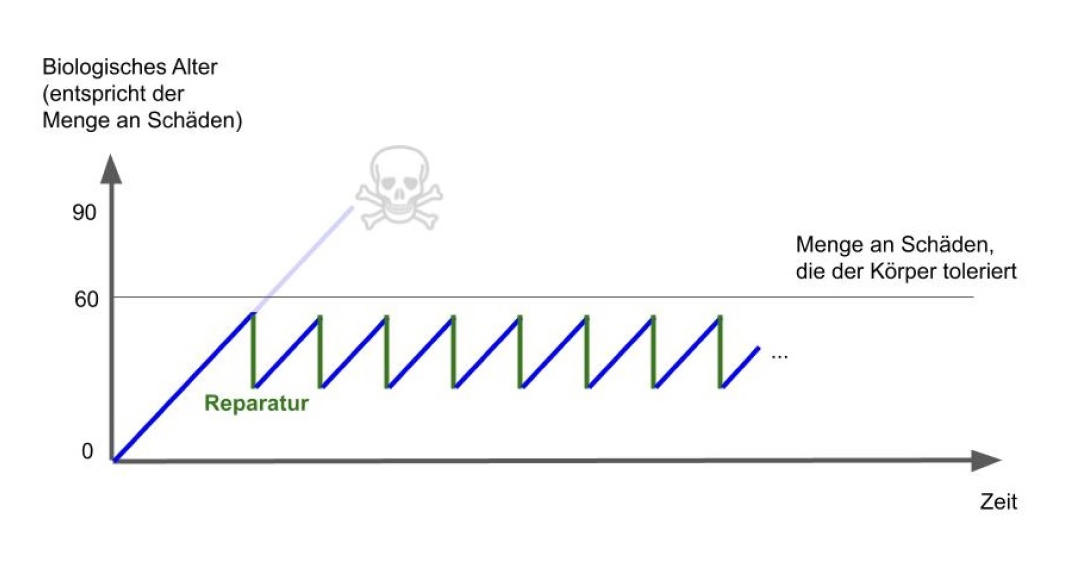
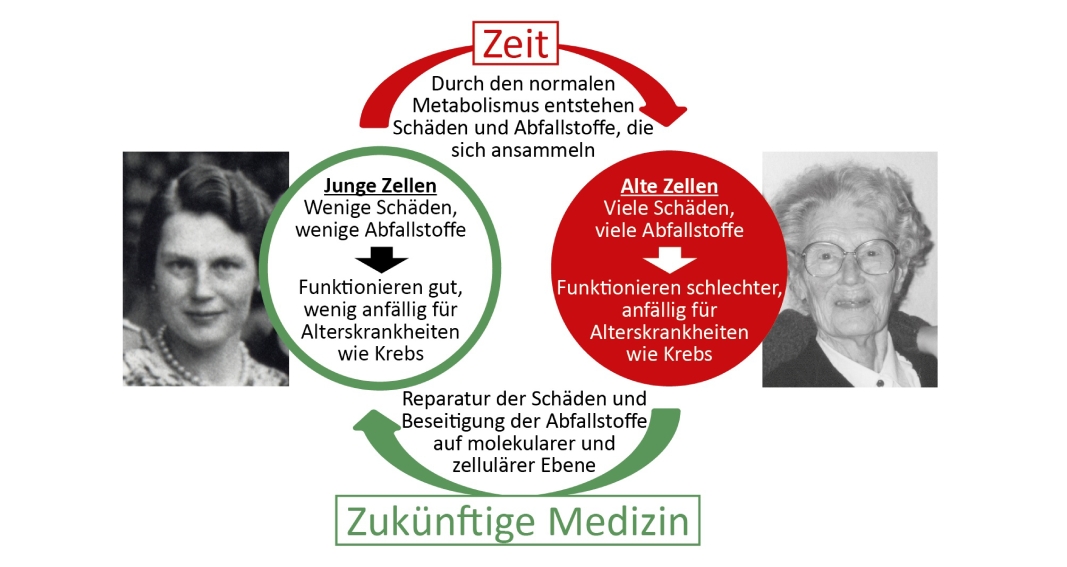
There is also “Plan B” offered by this party, in case the life extention won’t work out as planned. And the alternative is: Cryonics! There are even advertisement videos (“How to trick death with the help of cryonics“) of a German service provider for freezing your dead body in liquid nitrogen (or just the head, for the stingy customers), with a message:
“Registering with Tomorrow Biostasis is quick and easy at www.tomorrow.bio“
Scholarly Publishing
A report on Toxicology Reports
Maybe you remember the Elsevier journal Toxicology Reports? Its Editor-in-Chief used to be a certain russia-loving Greek antivaxxer Aristidis Tsatsakis. He has a PubPeer record, and you can read about him here:
On Dangers of Preprints
Antivaxxery in scientific literature – are preprints to blame?
Tsatsakis’ predecessor and successor as EiC of Toxicology Reports is the US professor Lawrence Lash, and Lash is not really a better character. Lash also has a PubPeer record, and you can read about his attitude as editor here:
Editors vs the Anonymous
A tale of brave academic editors fighting those bad, naughty, annoying anonymous whistleblower trolls
Now the pseudoscience debunker, image integrity sleuth and For Better Science contributor Sholto David published this preprint:
Sholto David, “A Quantitative Study of Inappropriate Image Duplication in the
Journal Toxicology Reports” bioRxiv (2023) doi: 10.1101/2023.09.03.556099
From the abstract:
“This study aimed to quantify the rate of image duplication in the journal Toxicology Reports. In total 1540 unique articles (identified by DOI) were checked for the presence of research related images (microscopy, photography, western blot scans, etc). Each research paper containing at least one such image was scrutinized for the presence of inappropriate duplications, first by manual review only, and subsequently with the assistance of an AI tool (ImageTwin.ai). Overall, Toxicology Reports published 715 papers containing relevant images, and 115 of these papers contained inappropriate duplications (16%). Screening papers with the use of ImageTwin.ai increased the number of inappropriate duplications detected, with 41 of the 115 being missed during the manual screen and subsequently detected with the aid of the software. In summary, the rate of inappropriate image duplication in this journal has been quantified at 16%, most of these errors could have been detected at peer review by careful reading of the paper and related literature. The use of ImageTwin.ai was able to increase the number of detected problematic duplications.”
16% of all research papers in this Elsevier journal contain duplications, i.e. possible falsifications. And it is not likely the editors will do anything to stop the fraud or correct the literature.
Read more about the editorial board of this awful journal here:
Elsevier’s Pandemic Profiteering
Aristidis Tsatsakis, Konstantinos Poulas, Ronald Kostoff, Michael Aschner, Demetrios Spandidos, Konstantinos Farsalinos: you will need a disinfecting shower once you read their papers.
Retraction Watchdogging
Author Elke Stein disagrees
Marc Tessier-Lavigne now resigned as President of Stanford University and retracted two Science papers. 8 years after they were exposed on PubPeer as fraudulent. The retraction notices are a passive-aggressive first-person diatribe where both the authors and the editors look like total fools.
Toppling Giants in Stanford
Everyone is talking about Stanford’s President Marc Tessier-Lavigne now. OK, let’s talk about him, and how Stanford deals with research fraud. And then let’s talk about Thomas Rando.
Retraction Nr 1:
Elke Stein , Marc Tessier-Lavigne Hierarchical Organization of Guidance Receptors: Silencing of Netrin Attraction by Slit Through a Robo/DCC Receptor Complex Science (2001) doi: 10.1126/science.1058445
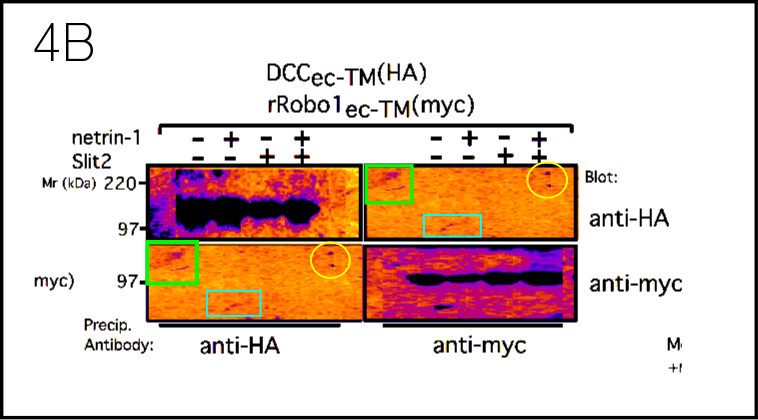
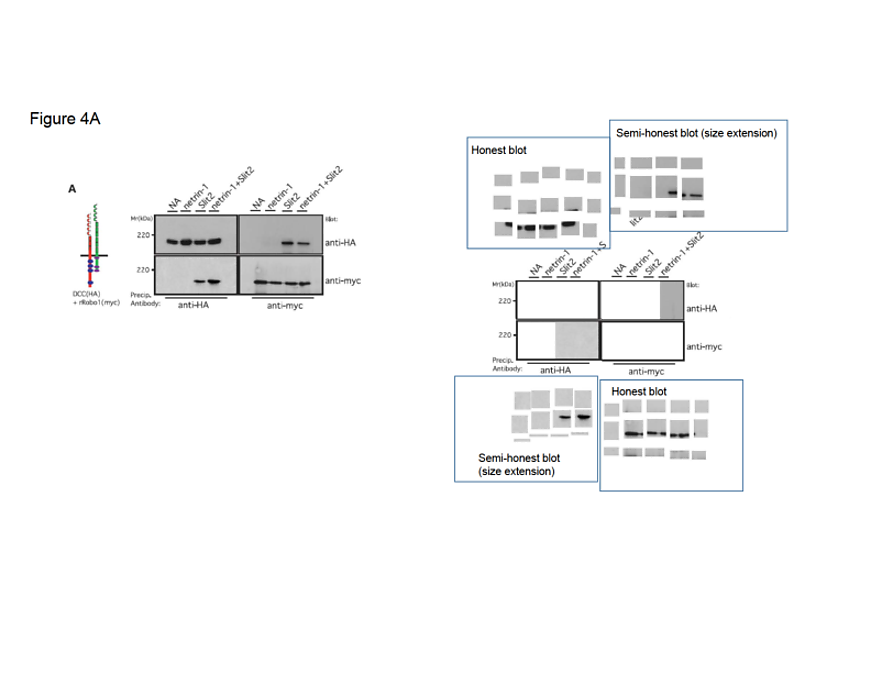
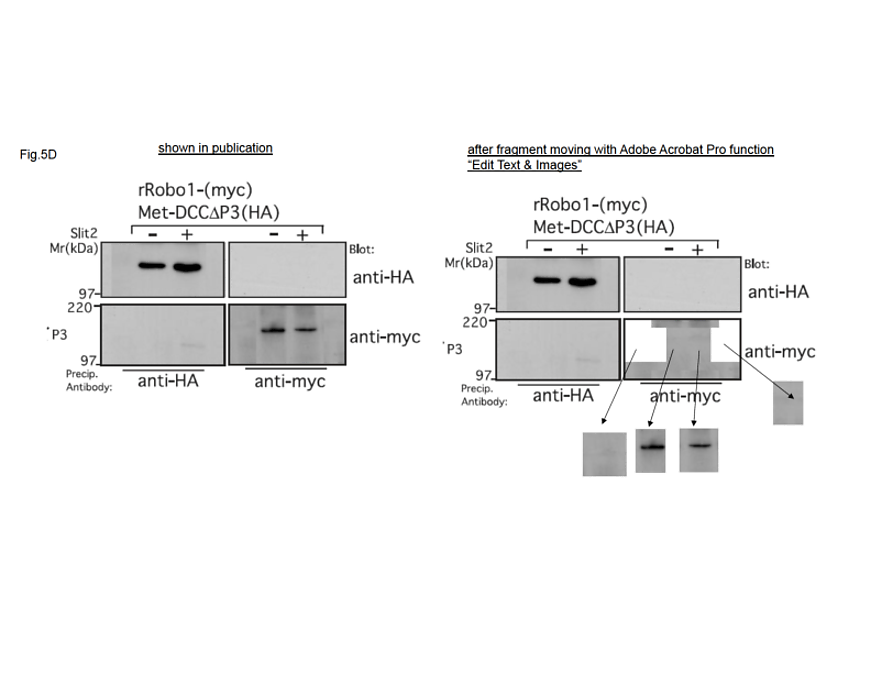



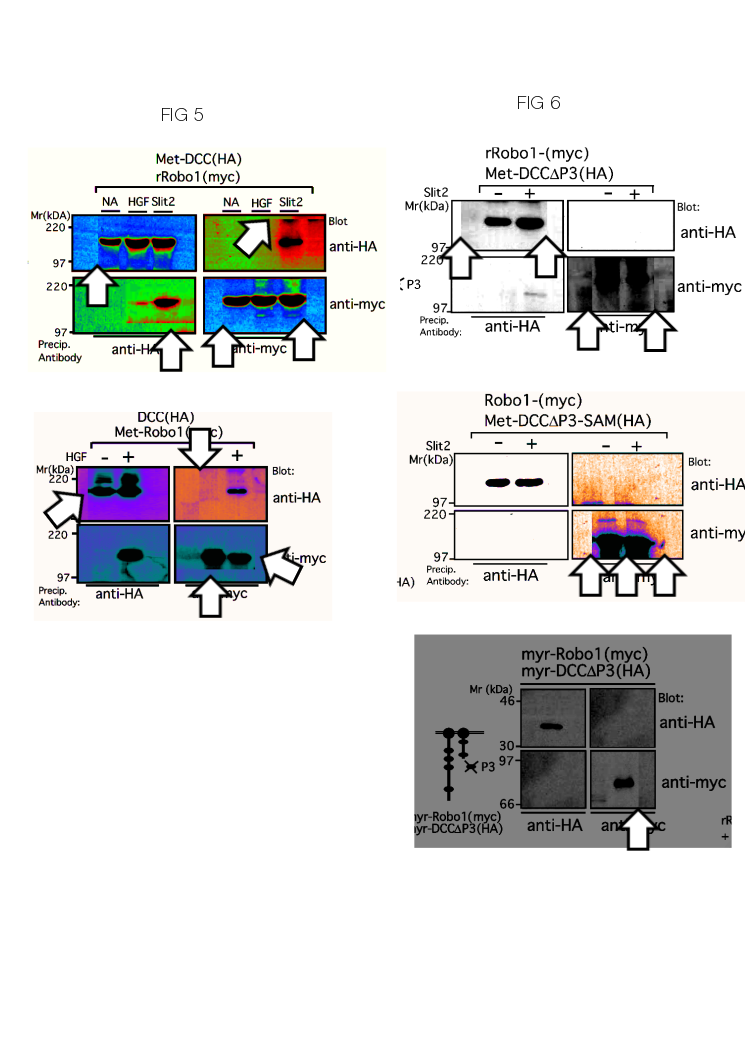
The Retraction notice from 1 September 2023 went (highlights mine):
“On 8 February 2001, Science published the Research Article “Hierarchical organization of guidance receptors: Silencing of netrin attraction by Slit through a Robo/DCC receptor complex” (1). In 2015, Science agreed to the publication of an Erratum to address issues that had come to the authors’ attention, specifically: in Figures 4, 5, and 6, beautification of some Western blots outside the data-containing portions (which was not formally disallowed at the time of publication) and some image breaks caused by formatting (“tiling”) issues, for which I provided corrected images, and panel duplications in Figures 2D (micrographs) and 4B (blank Western blots), and an incorrect blank panel in Figure 5E. However, because of an error on the part of the journal, the Erratum was not posted. In 2022, when new concerns were raised, Science posted an Editorial Expression of Concern (2) while an institutional investigation was conducted. The investigation is complete and has identified further issues, including manipulation of data-containing portions of Western blot images in Figure 4E and an additional panel duplication in Figure 5C, undermining confidence in the paper’s conclusions (3). As a result, I am retracting the paper. I regret the impact of these issues on the scientific community. Author Elke Stein disagrees with the decision to retract the paper.”
This is the second retraction:
Elke Stein , Yimin Zou , M Poo , Marc Tessier-Lavigne Binding of DCC by netrin-1 to mediate axon guidance independent of adenosine A2B receptor activation Science (2001) doi: 10.1126/science.1059391


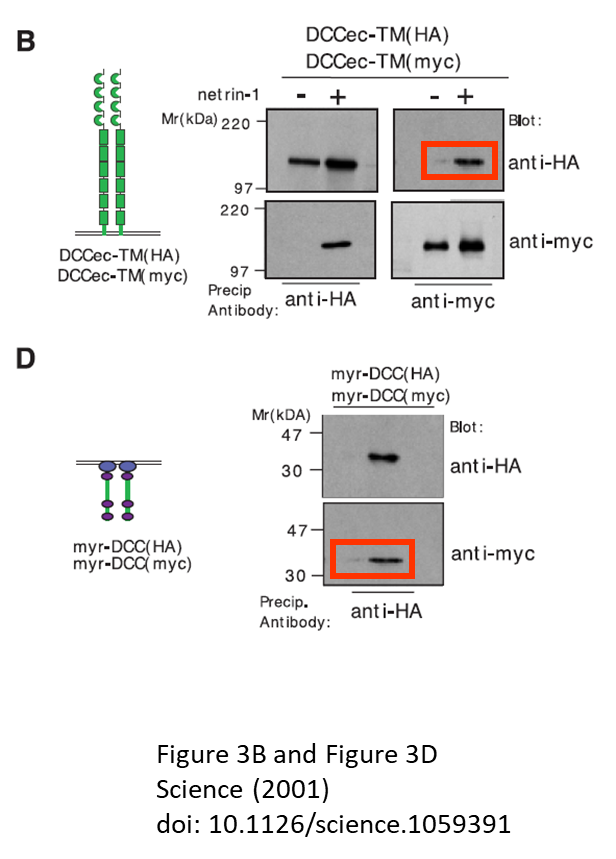
The Retraction notice from 1 December 2023 was similar (highlights mine):
“On 9 March 2001, Science published the Report “Binding of DCC by netrin-1 to mediate axon guidance independent of adenosine A2B receptor activation” (1). In 2015, Science agreed to the publication of an Erratum to address issues that had come to our attention, specifically: in Figures 1 and 3, beautification of some Western blots outside the data-containing portions (which was not formally disallowed at the time of publication) and some image breaks caused by formatting (“tiling”) issues, for which we provided corrected images. However, because of an error on the part of the journal, the Erratum was not posted. In 2022, when new concerns were raised, Science posted an Editorial Expression of Concern (2) while an institutional investigation was conducted. The investigation is complete and has identified further issues, including manipulation of data-containing portions of Western blot images in Figures 1, A and C, and 3, B and D, undermining confidence in the paper’s conclusions (3). As a result, we are retracting the paper. We regret the impact of these issues on the scientific community. Author Elke Stein disagrees with the decision to retract the paper.”
I wrote about Elke Stein before, and it seems so far absolutely nobody dared to write about her so far. Why? Too crazy? Too friendly with the Stanford President?


But now the student journalist Theo Baker writes in Stanford Daily:
“Stein first worked with Tessier-Lavigne during his time as a professor at the University of California San Francisco in the late nineties before relocating with him and his lab to Stanford in 2001 — the same year the retracted studies were published. According to one collaborator, some were already suspicious of Stein; it seemed “every experiment she does works perfectly, every time,” said the scientist, who requested anonymity for fear of professional repercussions from recounting their time working with Tessier-Lavigne. The colleague said that another lab working on netrin growth research around the time had failed to replicate parts of the studies now being retracted.
Around that time, concerns also began to emerge about the culture of Tessier-Lavigne’s lab, which the 2023 Stanford report said “tended to reward the ‘winners’ (that is, postdocs who could generate favorable results) and marginalize or diminish the ‘losers’ (that is, postdocs who were unable or struggled to generate such data).”
After Tessier-Lavigne went to Genentech, Stein moved to Yale, where she was a tenure-track professor. Still, she continued to interact with him. One principal investigator who ran a lab near Tessier-Lavigne at Genentech recalled that Stein would show up on occasion without explanation and introduce herself to others.
Stein did not get tenure at Yale, a university which requires those denied tenure to leave entirely. The circumstances are unclear, but Hank Greely, the Stanford Center for Law and the Biosciences director who offered Stein an unpaid fellowship in 2018, said he believed she had been denied tenure because “she had only published two papers in nine years.”
Scott Holley, now the chair of Yale’s Molecular, Cellular and Developmental Biology department, recalled her as “reclusive.” He said he had heard about problems in some of her work with Tessier-Lavigne in the mid-2000s, though not with any specificity.
After Stein came back to Stanford for her unpaid fellowship, Greely recalled trying to talk her out of applying for the associate provost for diversity position at the University, saying he did not think she was qualified. (Stein’s LinkedIn suggests that at the time she had not held a paying job for several years. It also prominently features one of the papers retracted today.) Following that conversation, Greely said he sent an email to Tessier-Lavigne, who replied that she “needed help.” Greely told The Daily that Tessier-Lavigne called Stein a “deeply troubled person.”
Since she left Stanford in 2019, it is unclear what Stein has been doing. Her LinkedIn, where she is still occasionally active, continues to list her as a fellow at a program that no longer exists.”
Stein is both a fraud and a looney, and Tessier-Lavigne is obviously a bully. In academia, ex-employees deemed as problematic won’t even be allowed to visit lavatories in universities where their former bosses have anything to say. Now, why would eminent people in Stanford like Hank Greely support Stein, if not to please the university’s president? Why would Greely and Tessier-Lavigne’s exchange emails to discuss another grown-up’s mental state?
Tessier-Lavigne’s and Stein’s relationship is probably not as boring and irrelevant as expert science journalists decided.
Frontiers in retractions
Frontiers recently started to mass-retract papermilled papers, probably in order to save their reputation as Hindawi does.
One “victim” of the clean-up is a certain Mostafa Jarahian, who pretends to be professor at the prestigious German cancer research institute DKFZ in Heidelberg, where he used to be a PhD student there many years ago. Eventually, after being pestered by Alexander Magazinov and myself, DKFZ did inform Frontiers of the fake affiliation (read here), and now some papers of his were retracted.
This one was purchased from the Latvia-based russian papermill Science Publisher:
Sadegh Shojaei Baghini , Zhanna R. Gardanova , Angelina Olegovna Zekiy , Navid Shomali , Foad Tosan, Mostafa Jarahian Optimizing sgRNA to Improve CRISPR/Cas9 Knockout Efficiency: Special Focus on Human and Animal Cell Frontiers in Bioengineering and Biotechnology (2021) doi: 10.3389/fbioe.2021.775309

Previously, the “author” Navid Shomali accused the Science Publisher papermill of having stolen his manuscript:
“Since the manuscripts were sent to free plagiarism detection websites, we assume the title and content of the manuscripts were abused to promote the specific pages.“
He refused to explain why he had to scan his own manuscript for plagiarism in the first place. Yet he said this, addressing the mysterious identitity of the russian “author”, the dentist Angelina Olegovna Zekiy:
“Concerning the mentioned author, since my friend, the corresponding author of this article (Dr. Jarahian), has been residing in Germany for more than 20 years and works at DKFZ, this collaboration has been established through him…“
The Retraction notice, from 4 September 2023 stated:
“Following publication, concerns were raised regarding the contributions of the authors of the article.
Our investigation, conducted in accordance with Frontiers policies, confirmed a serious breach of our authorship policies and of publication ethics; the article is therefore retracted.
The authors do not agree to this retraction.”
Frontiers in Homicidal Quackery
Guess what Frontiers now published.
Two more Jarahian papers were retracted by Frontiers with similar retraction notices.
Elham Zeinalzadeh , Alexey Valerievich Yumashev , Heshu Sulaiman Rahman , Faroogh Marofi , Navid Shomali , Hossein Samadi Kafil , Saeed Solali , Mehdi Sajjadi-Dokht , Sajjad Vakili-Samiani , Mostafa Jarahian , Majid Farshdousti Hagh The Role of Janus Kinase/STAT3 Pathway in Hematologic Malignancies With an Emphasis on Epigenetics Frontiers in Genetics (2021) doi: 10.3389/fgene.2021.703883 Retraction notice 4 September 2023

This one features famous papermillers like the russian Dmitry Bokov and the former EPA emplyoee and sacked Czech professor Rajender Varma:
Pooria Nakhaei , Ria Margiana , Dmitry O. Bokov , Walid Kamal Abdelbasset , Mohammad Amin Jadidi Kouhbanani , Rajender S. Varma , Faroogh Marofi , Mostafa Jarahian , Nasrin Beheshtkhoo Liposomes: Structure, Biomedical Applications, and Stability Parameters With Emphasis on Cholesterol Frontiers in Bioengineering and Biotechnology (2021) doi: 10.3389/fbioe.2021.705886
Retraction notice from 4 September 2023:
“Following publication, concerns were raised regarding the contributions of the authors of the article. Our investigation, conducted in accordance with Frontiers policies, confirmed a serious breach of our authorship policies and of publication ethics; the article is therefore retracted.
This retraction was approved by the Chief Editors of Frontiers in Bioengineering and Biotechnology and the Chief Executive Editor of Frontiers. The authors do not agree to this retraction.”
I, Rajender Varma, Highly Cited Researcher
“I could not comprehend the situation where a university picks up on individuals with an extraordinary and sterling performance and basically destroy one of the top European institutions. ” – Raj Varma
Meanwhile, Frontiers Executive Editor Frederick Fenter is trolling again:
“Frontiers has today published a new author policy designed to help prevent cases of “authorship-for-sale” among its research publications, a term used throughout the industry which refers to the unethical practice of buying or selling authorship on research papers.
“We recognize that there are legitimate reasons for the request of authorship changes after submission. However, to create real impact in reducing authorship-for-sale schemes, publishers must depend on responsible collaboration from our authors to ensure that their author lists are correct at the point of submission,” says Dr Frederick Fenter, chief executive editor of Frontiers. “
The real problem of course are the papermills selling authorships on Frontiers papers, not some of their customers failing to pay which then leads to authorship changes. Fenter now asks his papermill business partners to be considerate, to make all authorship sales final at submission stage, and not cause costly disturbances in Frontiers editorial workflow with authorship changes.
High number of concerns
Retraction for the Argentinian customer of Aneurus Inconstans, María Giselle Peters, group leader at the Instituto de Oncología Ángel H. Roffo in Buenos Aires. Read about her here:
Prof Elizalde’s Magic Cancer Research at CONICET
“No matter if the data behind medical protocols and oncological treatments are imaginary! Since science is long dead, we can always rely on the haruspices.” – Aneurus Inconstans
Buchanan C, Stigliano I, Garay-Malpartida HM, Rodrigues Gomes L, Puricelli L, Sogayar MC, Bal de Kier Joffé E, Peters MG Glypican-3 reexpression regulates apoptosis in murine adenocarcinoma mammary cells modulating PI3K/Akt and p38MAPK signaling pathways Breast Cancer Res Treat (2010) doi: 10.1007/s10549-009-0362-9





The Retraction notice was published on 4 September 2023:
“The Editor-in-Chief has retracted this article. After publication, concerns were raised regarding similarities in the western blot images presented in the figures.
Specifically:
- In Fig. 2a, the p21 lanes 1 and 2 appear highly similar.
- In Fig. 2b, the p27 lanes 3 and 4 appear highly similar.
- In Fig. 2e, the cyclin B1 and actin blots appear highly similar (flipped horizontally).
- In Fig. 3a, pErk1/2 lanes 7 and 11, and Erk1/2 lanes 4–6 and 7–9 appear highly similar.
- In Fig. 4a, pAkt lanes 2–3 and 5–6, and Akt lanes 5–8 and 9–12 appear highly similar.
The authors have provided alternative data to validate the results presented in Fig. 2, but have been unable to recover any original data for Figs. 3 and 4.
Due to the high number of concerns, the Editor-in-Chief no longer has confidence in the presented data.
Stigliano, L. Puricelli, E. Bal de Kier Joffé and M. G. Peters do not agree to this retraction. None of the other authors have responded to any correspondence from the editor or publisher about this retraction.”
Wake up and smell the coffee
Following last week’s Friday Shorts coverage, the obstetrics professor at St John’s University, Sandra Reznik, announced to retract a problematic paper forged by her PhD mentee, Yunali Ashar. The latter even tricked Reznik into uploading forged raw data on PubPeer to rebut the evidence.
Yunali Ashar , Qiuxu Teng , John N. D. Wurpel , Zhe-Sheng Chen , Sandra E. Reznik Palmitic Acid Impedes Extravillous Trophoblast Activity by Increasing MRP1 Expression and Function Biomolecules (2022) doi: 10.3390/biom12081162



And then Cheshire found this:

On 7 September 2023, Reznik wrote to me:
“I just wanted to let you know that I JUST RETRACTED THE MANUSCRIPT.”
She also thanked for my advice, and provided this statement about herself:
“…a shocked PI, who had been running a lab for 19 years and had never had a similar experience, and who trusted all her students and post-docs implicitly, needed a couple of weeks to wake up and smell the coffee. But she finally came to her senses and retracted the paper!”
We sure need more professors acting responsibly like Reznik, or like Ingrid Herr:
My little PubPeer saga – A wake-up call, by Ingrid Herr
“Dear colleagues, scientists, check your lab members’ raw data, publications, and dissertations even more thoroughly than before to protect scientific ethics and data integrity and maintain trust in science!” – Ingrid Herr
Science Breakthrough
Hasn’t been done before
Jacob Hanna, Israel’s greatest scientist and professor at Weizmann Institute, has made yet another groundbreaking discovery which once again revolutionised science and society.
BBC writes:
“Scientists have grown an entity that closely resembles an early human embryo, without using sperm, eggs or a womb.
The Weizmann Institute team say their “embryo model”, made using stem cells, looks like a textbook example of a real 14-day-old embryo.
It even released hormones that turned a pregnancy test positive in the lab. […]
This research, published in the journal Nature, is described by the Israeli team as the first “complete” embryo model for mimicking all the key structures that emerge in the early embryo.
“This is really a textbook image of a human day-14 embryo,” Prof Hanna says, which “hasn’t been done before”.
Instead of a sperm and egg, the starting material was naive stem cells which were reprogrammed to gain the potential to become any type of tissue in the body.
Chemicals were then used to coax these stem cells into becoming four types of cell found in the earliest stages of the human embryo”
The PubPeer Stars of Weizmann Institute
Rony Seger, Jacob Hanna, Ilana Kolodkin-Gal, Atan Gross, Sima Lev, Tsvee Lapidot, Moshe Oren, Varda Rotter and others. Let’s celebrate the Weizmann Science!
This is the Nature paper:
Bernardo Oldak , Emilie Wildschutz , Vladyslav Bondarenko , Mehmet-Yunus Comar , Cheng Zhao , Alejandro Aguilera-Castrejon , Shadi Tarazi , Sergey Viukov , Thi Xuan Ai Pham , Shahd Ashouokhi , Dmitry Lokshtanov , Francesco Roncato , Eitan Ariel , Max Rose , Nir Livnat , Tom Shani , Carine Joubran , Roni Cohen , Yoseph Addadi , Muriel Chemla , Merav Kedmi, Hadas Keren-Shaul, Vincent Pasque, Sophie Petropoulos, Fredrik Lanner, Noa Novershtern, Jacob H. Hanna Complete human day 14 post-implantation embryo models from naïve ES cells Nature (2023) doi: 10.1038/s41586-023-06604-5
13 months ago, Hanna published a similar kind of discovery, but with mouse cells (read earlier Friday Shorts). The paper Tarazi et al 2022 appeared in Cell. An artificial womb was introduced by Hanna to the world the year before, in the Nature paper Aguilera-Castrejon et al 2021. Hanna also founded a company, Renewal Bio, to monetize his high-profile publications. Already in 2015, he announced to be soon able to create embryos for same-sex couples using skin cells and iPS technology. Two years ago, Hanna was named “World’s Top Thinker 2021”.
The man goes from one breakthrough discovery to the next, one Nobel Prize will not be enough to reward Hanna for his artificial embryo technology. His past troubles with research integrity are not just forgotten, they probably serve as evidence of his genius.
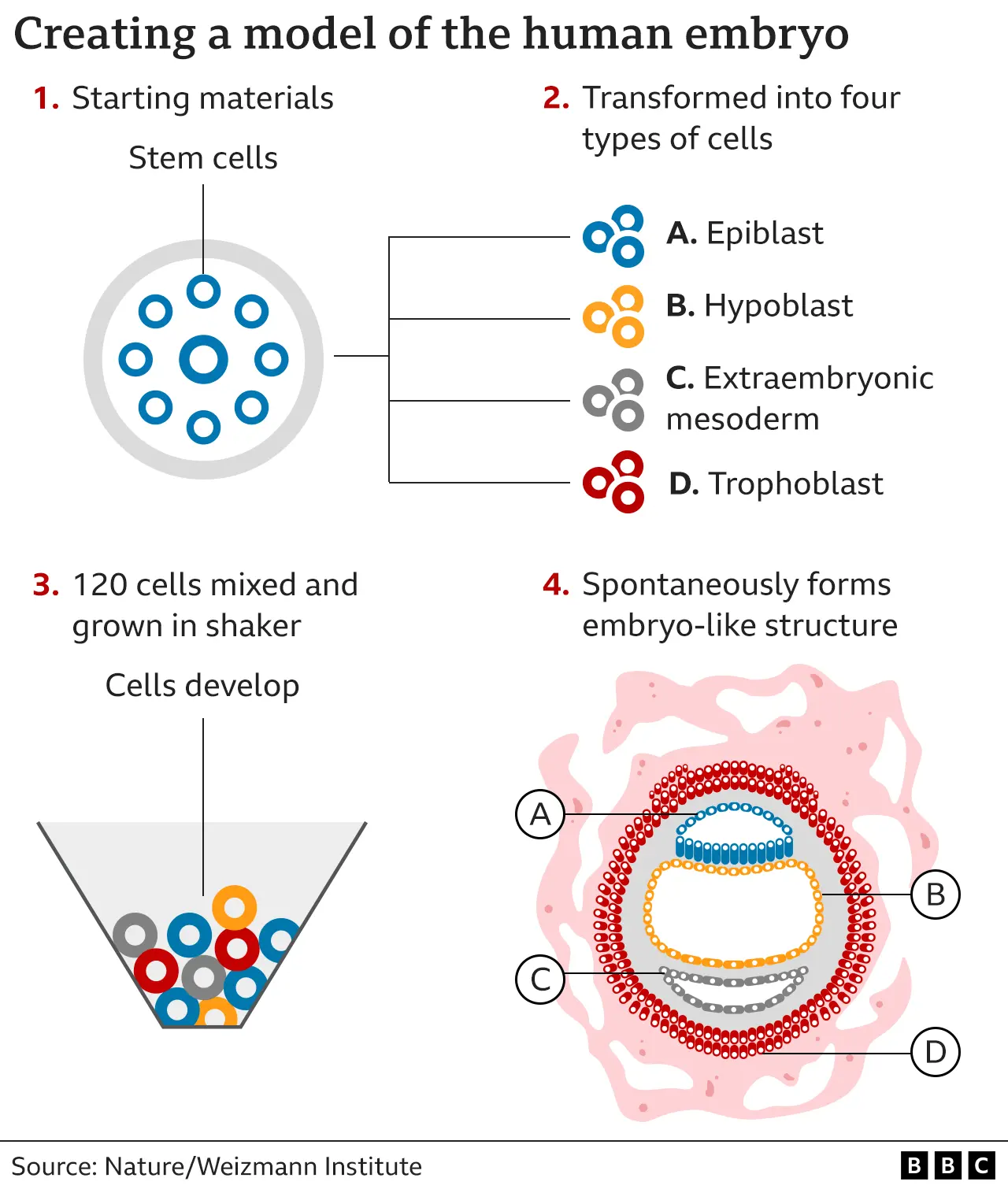
So are Hanna’s grandious discoveries real or not? Well, Hanna is making grand claims in top journals and revolutionising stem cell research for almost 15 years already, e.g in 2013 he presented a novel stem cell reprogramming technique, as Nature reported a decade ago:
“By removing a single protein, called Mbd3, a team at the Weizmann Institute of Science in Rehovot, Israel, was able to increase the conversion rate to almost 100% — ten times that normally achieved. The discovery could clear the way for scientists to produce large volumes of stem cells on demand, hastening the development of new treatments […]
But in work described today in Nature1, Weizmann stem-cell researcher Jacob Hanna and his team have reprogrammed cells with nearly 100% efficiency. Moreover, the researchers show that the cells all transition to pluripotency on a synchronized schedule.”
Instead of adapting the revolutionary technique to speed up science, Hanna’s peers, named and anonymous, started to heavily criticise his study, also on PubPeer.
Yoach Rais , Asaf Zviran , Shay Geula , Ohad Gafni , Elad Chomsky , Sergey Viukov , Abed AlFatah Mansour , Inbal Caspi , Vladislav Krupalnik , Mirie Zerbib , Itay Maza , Nofar Mor , Dror Baran , Leehee Weinberger , Diego A. Jaitin , David Lara-Astiaso , Ronnie Blecher-Gonen , Zohar Shipony , Zohar Mukamel , Tzachi Hagai , Shlomit Gilad, Daniela Amann-Zalcenstein, Amos Tanay, Ido Amit Noa Novershtern, Jacob H. Hanna Deterministic direct reprogramming of somatic cells to pluripotency Nature (2013) doi: 10.1038/nature12587
Are these celebrated artificial embryos and the womb just as reliable? Surely some peers can step forward and confirm having successfully reproduced any of Hanna’s groundbreaking discoveries, and maybe having built on them? Anyone? Hello? Hello???
Look people, if you want Professor Hanna to get his long-deserved Nobel Prize, you will have to come forward and confirm his findings.
Hope to the one billion individuals
After the LK-99 superconductor silliness, finally a scientifically founded, modest, measured, and perfectly down-to-earth press release from South Korea:
“A revolutionary discovery reveals that astrocytes, star-shaped cells in the brain, play a key role in regulating fat metabolism and obesity. These cells act on a cluster of neurons, known as the GABRA5 cluster, effectively acting as a “switch” for weight regulation.
A new drug, KDS2010, has been shown to facilitate weight loss in obese mice without reducing their food intake—even while consuming a high-fat diet. This could be a groundbreaking advancement in obesity treatment that allows people to lose weight without compromising appetite or avoiding fats.
Key Facts:
- Researchers have identified that the astrocytes in the lateral hypothalamus regulate a cluster of neurons (GABRA5) that act as a “switch” for weight regulation.
- The MAO-B enzyme in these astrocytes was identified as a target for obesity treatment, influencing GABA secretion and thus weight regulation.
- KDS2010, a selective and reversible MAO-B inhibitor, successfully led to weight loss in obese mice without impacting their food intake, even while consuming a high-fat diet, and is now in Phase 1 clinical trials.
This is a significant development that brings hope to the one billion individuals with obesity worldwide. Researchers led by Director C. Justin LEE from the Center for Cognition and Sociality (CCS) within the Institute for Basic Science (IBS) have discovered new insights into the regulation of fat metabolism.”
The magic pill for slimness was published in one of those newer Nature family journals set up to scavenge the trash rejected upstairs.
Moonsun Sa , Eun-Seon Yoo , Wuhyun Koh , Mingu Gordon Park , Hyun-Jun Jang , Yong Ryoul Yang , Mridula Bhalla , Jae-Hun Lee , Jiwoon Lim , Woojin Won , Jea Kwon , Joon-Ho Kwon , Yejin Seong , Byungeun Kim , Heeyoung An , Seung Eun Lee , Ki Duk Park , Pann-Ghill Suh , Jong-Woo Sohn , C. Justin Lee Hypothalamic GABRA5-positive neurons control obesity via astrocytic GABA Nature Metabolism (2023) doi: 10.1038/s42255-023-00877-w
Naturally, this statement in the paper is a lie:
“The authors declare no competing interests.”
ChangJoon Justin Lee holds patents on a MAO-B inhibitors, together with his coauthor Ki Duk Park. More importantly: the two men own jointly (as “original inventors”) a biotech company named Neurobiogen which seeks to market this same MAO-B inhibitor SeReMABI/KDS2010 as a cure for obesity and also, per company’s pipeline, for Alzheimer’s, Parkinson’s, stroke, spinal cord injury, traumatic brain injury, multiple sclerosis and amyotrophic lateral sclerosis. The company website is full of recent Korean-language media articles advertising for the above publication and KDS2010, one such randomly clicked news-piece openly states (Google-translated):
“the technology was transferred to Neurobiogen in 2019, and is currently undergoing a phase 1 clinical trial, and an experiment was conducted in which a selective and reversible Maobi inhibitor ‘KDS2010’, which is scheduled for a phase 2 clinical trial in 2024, was administered to an obese mouse model.”
This crap is already being tested on humans. Thank you, Nature Metabolism who didn’t even bother to check which patents their esteemed yet dishonest authors hold.
Pontus Boström: cheater carousel in Sweden
Sweden is a tolerant country, which is a very good thing. Unfortunately, sometimes this Swedish tolerance seems ill-advised. Dishonest scientists caught faking data are happily given another chance and fat funding, like the case of the diabetes researcher Pontus Boström shows. This scientist was found to have fabricated data during his PhD studies with late…
A 226% increase in cognitive capacity
A press release by University of California – Irvine:
“When a fragrance wafted through the bedrooms of older adults for two hours every night for six months, memories skyrocketed. In fact, participants in this study by neuroscientists from the University of California, Irvine (UCI), reaped a 226% increase in cognitive capacity compared to the control group. The researchers say the finding transforms the long-known tie between smell and memory into an easy, non-invasive technique for strengthening memory and potentially deterring dementia.
The team’s study was published recently in the journal Frontiers in Neuroscience.”
Here it is:
Cynthia C. Woo, Blake Miranda, Mithra Sathishkumar, Farideh Dehkordi-Vakil, Michael A. Yassa and Michael Leon, “Overnight olfactory enrichment using an odorant diffuser improves memory and modifies the uncinate fasciculus in older adults” Frontiers in Neuroscience (2023) DOI: 10.3389/fnins.2023.1200448
How the study worked:
“It involved men and women aged 60 to 85 without memory impairment. All were given a diffuser and seven cartridges, each containing a single and different natural oil. People in the enriched group received full-strength cartridges. Control group participants were given the oils in tiny amounts. Participants put a different cartridge into their diffuser each evening prior to going to bed, and it activated for two hours as they slept.
People in the enriched group showed a 226% increase in cognitive performance compared to the control group, as measured by a word list test commonly used to evaluate memory.”
As Cheshire commented on Twitter/X:
“The “study” has everything one might suspect:
- essential oils
- published in @FrontiersIn
- authors directly compensated by sponsor
- some study arms not reported in paper
- cognitive assessment only included 23 people”
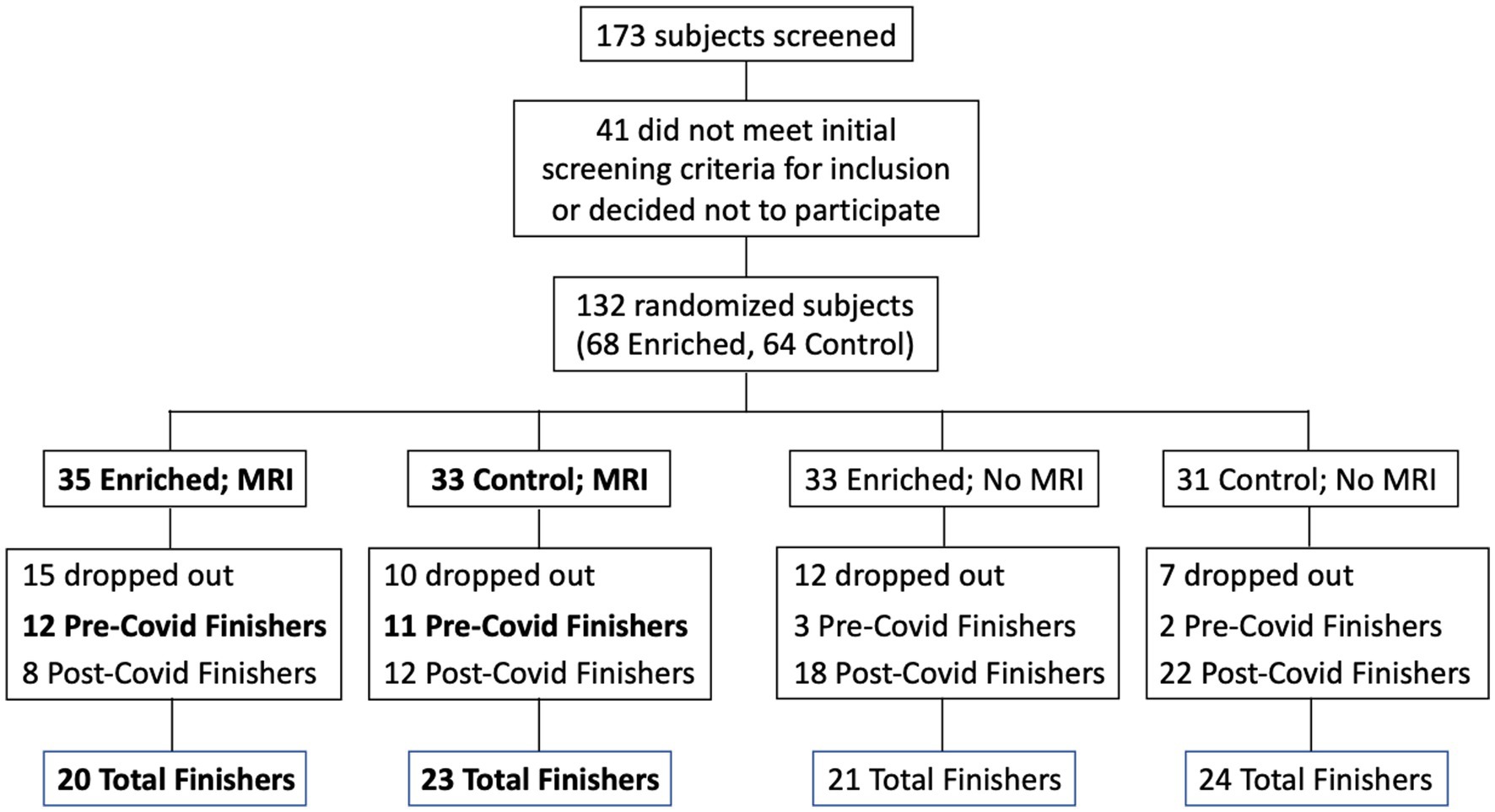
And, ta-da:
“A product based on their study and designed for people to use at home is expected to come onto the market this fall. […] The study was supported by Procter & Gamble.”
P&G was indeed listed as official “collaborator” of the clinical study NCT03914989. We are also informed that UCI Center for the Neurobiology of Learning & Memory director Michael Yassa and its professor Michael Leon “have received travel expenses and compensation following presentations at P&G.”
Frontiers: a danger for public health?
Frontiers is a somewhat unconventional open access publisher, which likes to have it both ways: playing scientific elite while accepting almost anything from paying customers. My regular contributor Smut Clyde will tell you below how some anti-vaccine scare-mongers managed to sneak in some rather dangerous works thanks to Frontiers’ unofficial “we don’t judge, we just…
There is a cheaper way than buying P&G product. All you need is a strong odour. Basically, if you fart in bed, you will increase your own and your partner’s intelligence. Science has spoken.
I thank all my donors for supporting my journalism. You can be one of them!
Make a one-time donation:
I thank all my donors for supporting my journalism. You can be one of them!
Make a monthly donation:
Choose an amount
Or enter a custom amount
Your contribution is appreciated.
Your contribution is appreciated.
DonateDonate monthly

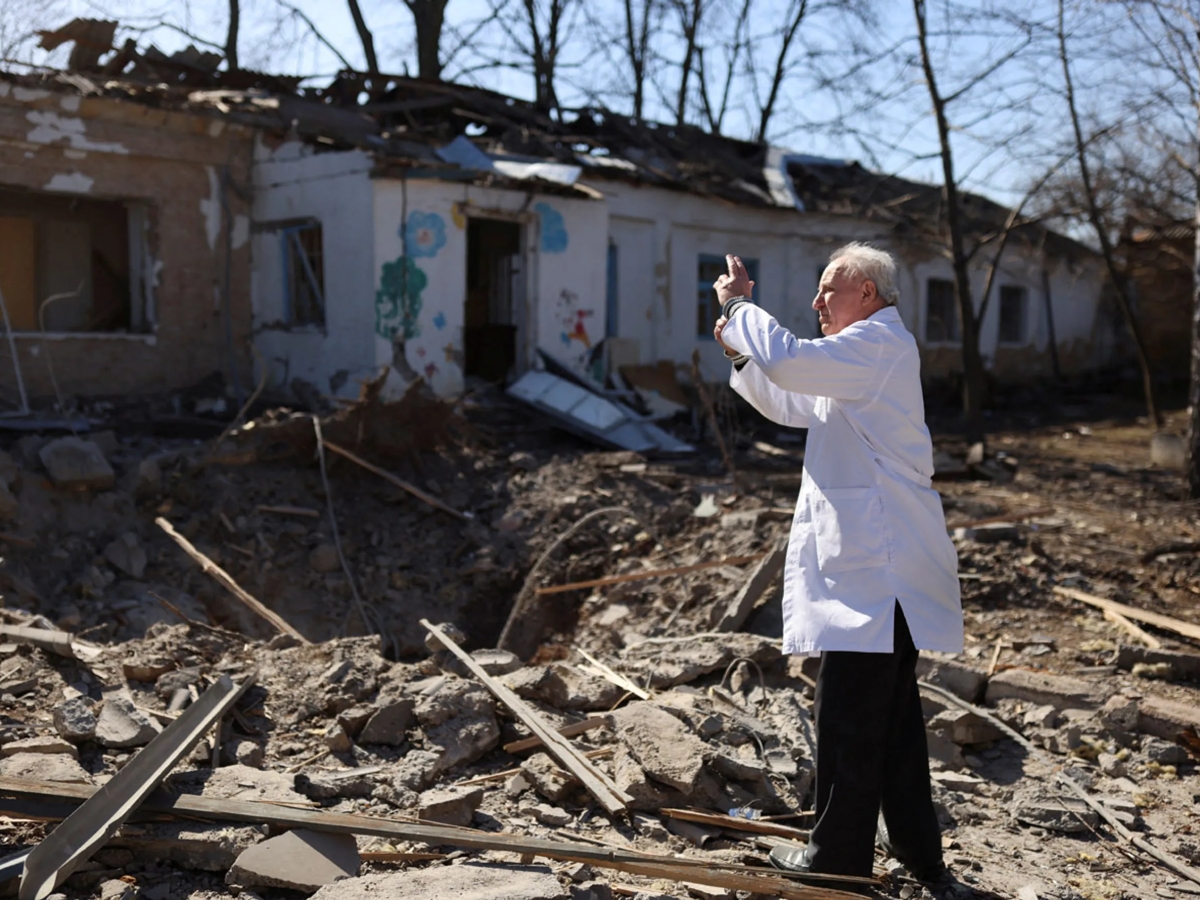








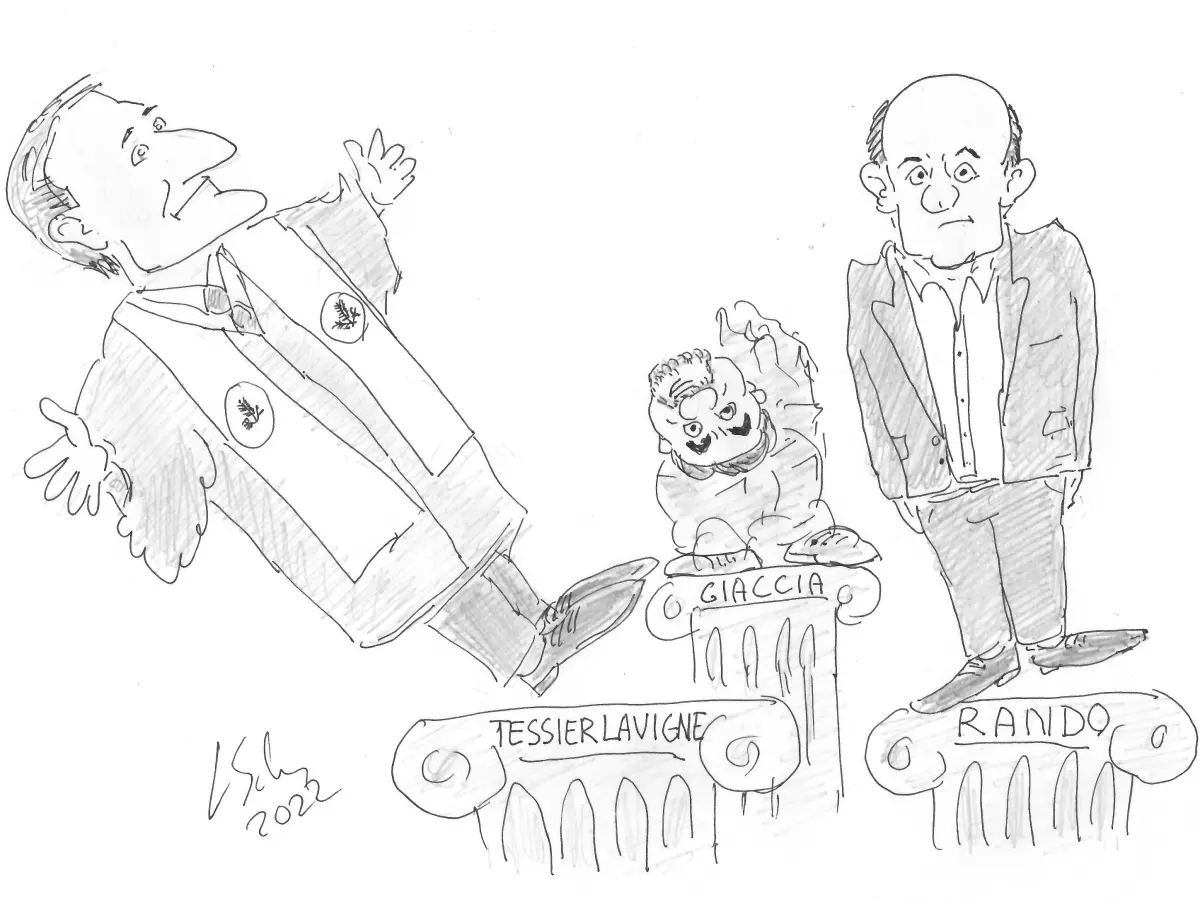




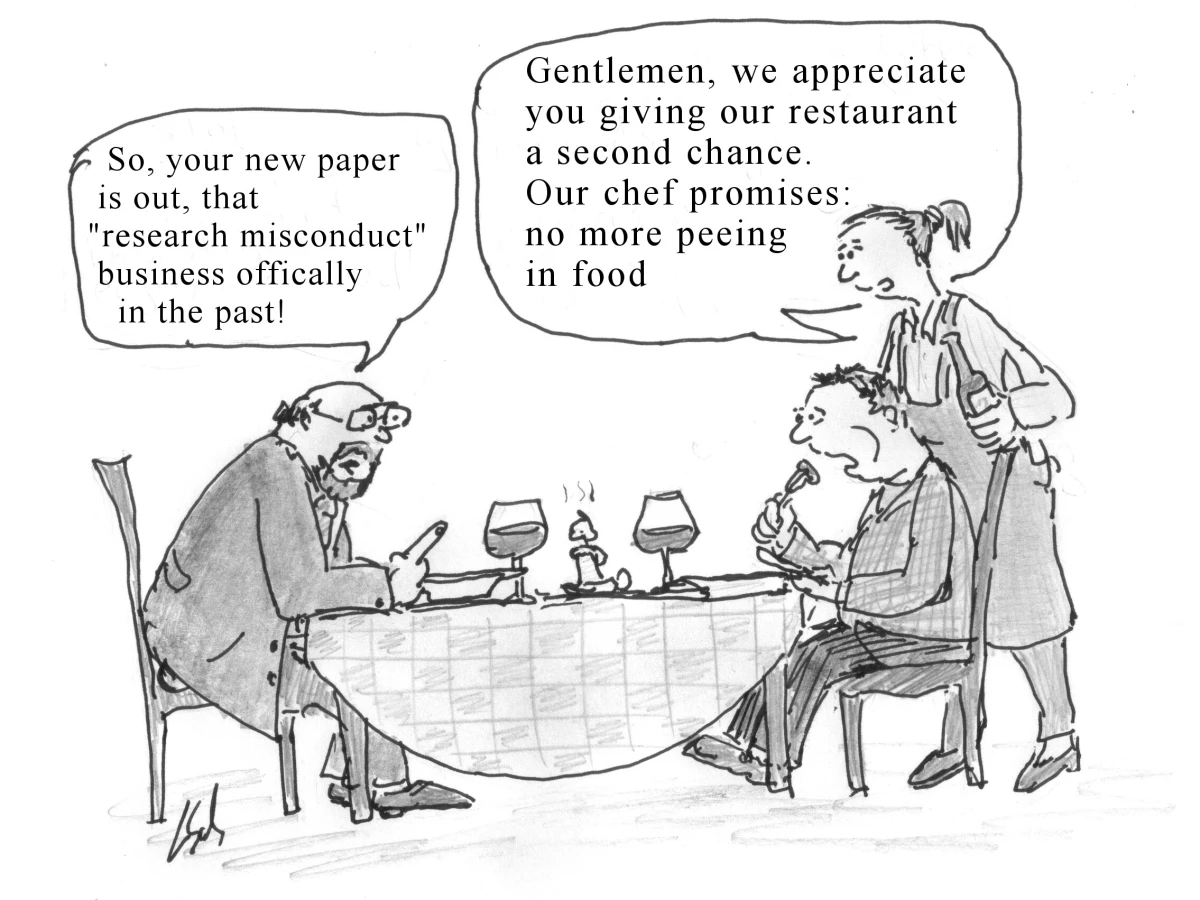



P&G seems late to the ‘olfactory enrichment’ game:
Researchers from Cima University of Navarra (Spain) report:
‘Menthol inhalation can improve cognitive abilities in animal models of Alzheimer’s disease.’ (!)
https://www.frontiersin.org/articles/10.3389/fimmu.2023.1130044/full
LikeLike
for example from the papermiller Arash Karimipour
Meanwhile, Karimipour is the last man standing from the trio Afrand-Karimi-Karimipour who still remains an editor of Engineering Analysis with Boundary Elements. After Afrand, Karimi is also gone.
LikeLike
Among Kostya Ostrikov’s collaborators, an interesting character is spotted: Mahmood Ghoranneviss. Currently they have 4 common publications:
https://app.dimensions.ai/discover/publication?and_facet_researcher=ur.01175235121.92&and_facet_researcher=ur.016302312237.66
Ghoranneviss has scored at least 36 retractions, which would virtually place him shared 15th on Retraction Watch Leaderbord (RW has to catch up). I have a spreadsheet for these retractions:
https://docs.google.com/spreadsheets/d/1xPrl2viSQ1JrvxPQDtDLJ-dSeI3O1mwVcMQ4xIrSXJA/edit?usp=sharing
LikeLike